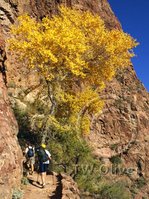If you're in the Phoenix, Arizona area the Phoenix Art Museum has a new exhibit running from now until February 4, 2007. Modern by Nature: Ansel Adams in the 1930s inaugurates the Museum’s new Norton photography gallery. The exhibition includes 62 amazing photographs from a single decade out of his sixty year career. If you’ve never seen Ansel Adams prints on display in a museum setting, you will not want to miss this exhibit. The link above provides more information as well as museum location and hours.
Tuesday, November 21, 2006
Thursday, November 16, 2006
Sony A100 Goes For A Walk
 I recently joined the one percent of Grand Canyon visitors that actually hike to the bottom of the canyon. Most folks don’t go all the way to the bottom, in this instance a seven mile hike down South Kaibab trail and ten miles up on Bright Angel Trail. I took my recently acquired Sony Alpha 100 out for its first adventure trip and it performed very well. An important aspect of hiking the canyon is to pack as little as possible, so I restricted myself to the camera body, 18-70mm kit lens and the classic Minolta Maxxum 70-210mm f4 lens, which gave me a 105-315mm range on the digital Alpha 100. A standard tripod was out of the question, but my small monopod was an acceptable accessory to carry on this trip. This hike put the in-camera, anti-shake feature of the A100 to the test. It worked well for the inevitable hand-held, low light shots. This first example I uses the 18-70mm f3.5-5.6 Sony kit lens (rebadged Minolta lens.)
I recently joined the one percent of Grand Canyon visitors that actually hike to the bottom of the canyon. Most folks don’t go all the way to the bottom, in this instance a seven mile hike down South Kaibab trail and ten miles up on Bright Angel Trail. I took my recently acquired Sony Alpha 100 out for its first adventure trip and it performed very well. An important aspect of hiking the canyon is to pack as little as possible, so I restricted myself to the camera body, 18-70mm kit lens and the classic Minolta Maxxum 70-210mm f4 lens, which gave me a 105-315mm range on the digital Alpha 100. A standard tripod was out of the question, but my small monopod was an acceptable accessory to carry on this trip. This hike put the in-camera, anti-shake feature of the A100 to the test. It worked well for the inevitable hand-held, low light shots. This first example I uses the 18-70mm f3.5-5.6 Sony kit lens (rebadged Minolta lens.) The second example features the Maxxum 70-210mm f4. The A100 is just so fun and easy to use. Controls and menus are accessible quickly, image quality is excellent, and the LCD is large enough to get a good grasp of the exposure…but always look at the histogram. Also I used the popular cheating technique of bracketing. It will be a while before I hike back down to the bottom of the Grand Canyon so I wanted to ensure I captured correctly exposed images. Also, since I went with five friends, I didn’t want to hold things up too much while taking photos on the way down or back up. Anti-shake and bracketing greatly improved my ability to quickly compose, expose and capture the beauty of the Grand Canyon. As a long-time Minolta Maxxum user I can see why Popular Photography and Imaging magazine chose the Sony Alpha 100 as their DSLR of the year for 2006.
The second example features the Maxxum 70-210mm f4. The A100 is just so fun and easy to use. Controls and menus are accessible quickly, image quality is excellent, and the LCD is large enough to get a good grasp of the exposure…but always look at the histogram. Also I used the popular cheating technique of bracketing. It will be a while before I hike back down to the bottom of the Grand Canyon so I wanted to ensure I captured correctly exposed images. Also, since I went with five friends, I didn’t want to hold things up too much while taking photos on the way down or back up. Anti-shake and bracketing greatly improved my ability to quickly compose, expose and capture the beauty of the Grand Canyon. As a long-time Minolta Maxxum user I can see why Popular Photography and Imaging magazine chose the Sony Alpha 100 as their DSLR of the year for 2006. Popular Fuji Slide Film To Return, Sort Of...

Fuji has announced they will introduce a color slide film similar to their popular but discontinued Fujichrome Velvia 50. Here is the article from PopPhoto.com.
Subscribe to:
Posts (Atom)
